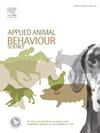Hand preferences in captive non-human primates are associated with generation and stress level
IF 2.2
2区 农林科学
Q1 AGRICULTURE, DAIRY & ANIMAL SCIENCE
引用次数: 0
Abstract
Hand-use preferences of non-human primates are affected by various factors, such as posture and task difficulty. Additionally, the degree of lateralization may be a useful indicator for evaluating the welfare of non-human primates, but more empirical studies are needed to explore the relationship between lateralization and stress levels. In this study, we compared the handedness of four groups of Callitrichids at Nanjing Hongshan Forest Zoo during two tasks, simple reaching and reaching into a feeder, as well as the handedness of subjects that repeated the simple reaching task at a one-year interval. The subjects did not display different levels of hand preference (including direction and strength of hand preference) across four groups in the two different tasks, and 26 marmosets showed a stronger hand preference (absolute handedness index [ABS-HI]) in the repeated simple reaching task one year later. Individual factors such as sex and generation significantly impacted individual hand preference; in particular, the strength of hand preference in all three tests differed significantly across generations. The results revealed that individuals with high ABS-HI have higher levels of fecal cortisol in golden-handed tamarins (Saguinus midas), implying an association between handedness and physiological stress, which suggested the potential of using handedness as an indicator for assessing physiological stress in captive non-human primates in the future, thus contributing to enhancing animal welfare.
圈养非人灵长类动物的手部偏好与世代和应激水平有关
非人类灵长类动物的手部使用偏好受到多种因素的影响,如姿势和任务难度。此外,侧化程度可能是评估非人类灵长类动物福利的一个有用指标,但需要更多的实证研究来探索侧化与应激水平之间的关系。在本研究中,我们比较了南京红山森林动物园四组猕猴在简单伸手和伸手到喂食器两个任务中的手性,以及每隔一年重复一次简单伸手任务的被试的手性。四组被试在两种不同的任务中并没有表现出不同程度的手偏好(包括手的方向和力量偏好),一年后,26只狨猴在重复的简单伸手任务中表现出更强的手偏好(绝对手性指数[ABS-HI])。性别和代际等个体因素显著影响个体的手偏好;特别是,在所有三个测试中,手偏好的强度在几代人之间存在显著差异。结果表明,高ABS-HI个体在金手绢毛猴(Saguinus midas)中具有较高的粪便皮质醇水平,这意味着手性与生理应激之间存在关联,这表明在未来将手性作为评估圈养非人灵长类动物生理应激的指标,从而有助于提高动物福利。
本文章由计算机程序翻译,如有差异,请以英文原文为准。
求助全文
约1分钟内获得全文
求助全文
来源期刊

Applied Animal Behaviour Science
农林科学-行为科学
CiteScore
4.40
自引率
21.70%
发文量
191
审稿时长
18.1 weeks
期刊介绍:
This journal publishes relevant information on the behaviour of domesticated and utilized animals.
Topics covered include:
-Behaviour of farm, zoo and laboratory animals in relation to animal management and welfare
-Behaviour of companion animals in relation to behavioural problems, for example, in relation to the training of dogs for different purposes, in relation to behavioural problems
-Studies of the behaviour of wild animals when these studies are relevant from an applied perspective, for example in relation to wildlife management, pest management or nature conservation
-Methodological studies within relevant fields
The principal subjects are farm, companion and laboratory animals, including, of course, poultry. The journal also deals with the following animal subjects:
-Those involved in any farming system, e.g. deer, rabbits and fur-bearing animals
-Those in ANY form of confinement, e.g. zoos, safari parks and other forms of display
-Feral animals, and any animal species which impinge on farming operations, e.g. as causes of loss or damage
-Species used for hunting, recreation etc. may also be considered as acceptable subjects in some instances
-Laboratory animals, if the material relates to their behavioural requirements
 求助内容:
求助内容: 应助结果提醒方式:
应助结果提醒方式:


